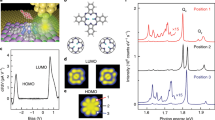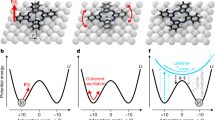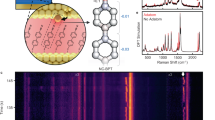Abstract
Although noise is observed in many experiments, it is rarely used as a source of information. However, valuable information can be extracted from noisy signals. The motion of particles on a surface induced, for example, by thermal activation1,2,3,4 or by the interaction with the tip of a scanning tunnelling microscope5,6 may lead to fluctuations or switching of the tunnelling current3,4,5,7,8,9,10,11,12,13,14,15,16,17,18,19,20,21. The analysis of these processes gives insight into dynamics on a single atomic or molecular level. Unfortunately, scanning tunnelling microscopy (STM) is not a useful tool to study dynamics in detail, as it is an intrinsically slow technique. Here, we show that this problem can be solved by providing a full real-time characterization of random telegraph noise in the current signal. The hopping rate, the noise amplitude and the relative occupation of the involved states are measured as a function of the tunnelling parameters, providing spatially resolved maps. In contrast to standard STM, our technique gives access to transiently populated states revealing an electron-driven hindered rotation between the equilibrium and two metastable positions of an individually adsorbed molecule. The new approach yields a complete characterization of copper phthalocyanine molecules on Cu(111), ranging from dynamical processes on surfaces to the underlying electronic structure on the single-molecule level.
This is a preview of subscription content, access via your institution
Access options
Subscribe to this journal
Receive 12 print issues and online access
$259.00 per year
only $21.58 per issue
Buy this article
- Purchase on Springer Link
- Instant access to full article PDF
Prices may be subject to local taxes which are calculated during checkout




Similar content being viewed by others
References
Gimzewski, J. K. et al. Rotation of a single molecule within a supramolecular bearing. Science 281, 531–533 (1998).
Stöhr, M. et al. Direct observation of a hindered eccentric rotation of an individual molecule: Cu-phthalocyanine on C60 . Phys. Rev. B 65, 033404 (2001).
Gao, L. et al. Constructing an array of anchored single-molecule rotors on gold surfaces. Phys Rev. Lett. 101, 197209 (2008).
Kühne, D. et al. Rotational and constitutional dynamics of caged supramolecules. Proc. Natl Acad. Sci. USA 107, 21332–21336 (2010).
Eigler, D. M., Lutz, C. P. & Rudge, W. E. An atomic switch realized with the scanning tunneling microscope. Nature 352, 600–603 (1991).
Jung, T. A., Schlittler, R. R., Gimzewski, J. K., Tang, H. & Joachim, C. Controlled room-temperature positioning of single molecules: Molecular flexure and motion. Science 271, 181–184 (1996).
Stipe, B. C., Rezaei, M. A. & Ho, W. Inducing and viewing the rotational motion of a single molecule. Science 279, 1907–1909 (1998).
Lauhon, M. A. & Ho, W. Control and characterization of a unimolecular reaction. Phys. Rev. Lett. 84, 1527–1530 (2000).
Pascual, J. I., Lorente, N., Song, Z., Conrad, H. & Rust, H-P. Selectivity in vibrationally mediated single-molecule chemistry. Nature 423, 525–528 (2003).
Stroscio, J. A. & Celotta, R. J. Controlling the dynamics of a single atom in lateral atom manipulation. Science 306, 242–247 (2004).
Iancu, V. & Hla, S-W. Realization of a four-step molecular switch in scanning tunneling microscope manipulation of single chlorophyll-A molecules. Proc. Natl Acad. Sci. USA 103, 13718–13718 (2006).
Liljeroth, P., Repp, J. & Meyer, G. Current-induced hydrogen tautomerization and conductance switching of naphthalocyanine molecules. Science 317, 1203–1206 (2007).
Henningsen, N. et al. Inducing the rotation of a single phenyl ring with tunneling electrons. J. Phys. Chem. C 111, 14843–14848 (2007).
Wang, Y., Kröger, J., Berndt, R. & Hofer, A. Pushing and pulling a Sn ion through an adsorbed phthalocyanine molecule. J. Am. Chem. Soc. 131, 3639–3643 (2009).
Nacci, C. et al. Current versus temperature-induced switching in a single-molecule tunnel junction: 1,5 cyclooctadiene on Si(001). Nano Lett. 9, 2996–3000 (2009).
Karacuban, H. et al. Substrate-induced symmetry reduction of CuPc on Cu(111): An LT-STM study. Surf. Sci. 603, L39–L43 (2009).
Tierney, H. L. et al. Mode-selective electrical excitation of a molecular rotor. Chem. Eur. J. 15, 9678 (2009).
Simic-Milosevic, V., Meyer, J. & Morgenstern, K. Chirality change of chloronitrobenzene on Au(111) induced by inelastic electron tunneling. Angew. Chem. Int. Ed. 48, 4061–4064 (2009).
Van Houselt, A. & Zandvliet, H. J. W. Colloquium: Time-resolved scanning tunneling microscopy. Rev. Mod. Phys. 82, 1593–1605 (2010).
Liu, Q. et al. Identifying multiple configurations of complex molecules in dynamical processes: Time resolved tunneling spectroscopy and density functional theory calculation. Phys. Rev. Lett. 104, 166101 (2010).
Wang, W. et al. Electron stimulation of internal torsion of a surface-mounted molecular rotor. ACS Nano 4, 4929–4935 (2010).
Bartels, L., Wang, F., Möller, D., Knoesel, E. & Heinz, T. F. Real-space observation of molecular motion induced by femtosecond laser pulses. Science 305, 648–651 (2004).
Eigler, D. M. & Schweizer, E. K. Positioning single atoms with a scanning tunnelling microscope. Nature 344, 524–526 (1990).
Hla, S-W., Braun, K-F., Wassermann, B. & Rieder, K-H. Controlled low-temperature molecular manipulation of sexiphenyl molecules on Ag(111) using scanning tunneling microscopy. Phys. Rev. Lett. 93, 208302 (2004).
Heinrich, B. W. et al. Direct observation of the tunneling channels of a chemisorbed molecule. J. Phys. Chem. Lett. 1, 1517–1523 (2010).
Teillet-Billy, D., Gauyacq, J-P. & Persson, M. Molecular rotation induced by inelastic electron tunneling. Phys. Rev. B 62, R13306–R13309 (2000).
Lorente, N. & Gauyacq, J-P. Efficient spin transitions in inelastic electron tunneling spectroscopy. Phys. Rev. Lett. 103, 176601 (2009).
Abram, R. A. & Herzenberg, A. Rotational excitation of H2 by slow electrons. Chem. Phys. Lett. 3, 187–190 (1969).
Stadtmüller, B., Kröger, I., Reinert, F. & Kumpf, C. Submonolayer growth of CuPc on noble metal surfaces. Phys. Rev. B 83, 085416 (2011).
Kresse, G. & Hafner, J. Norm-conserving and ultrasoft pseudopotentials for first-row and transition elements. J. Phys. Condens. Matter. 6, 8245–8257 (1994).
Acknowledgements
Financial support by the Deutsche Forschungsgemeinschaft through the SFB 616 Energy Dissipation at Surfaces is gratefully acknowledged. M.C.C. and A.S. thank the Studienstiftung des deutschen Volkes for support. D. Utzat is gratefully acknowledged for designing and constructing the electronics.
Author information
Authors and Affiliations
Contributions
J.S., M.C.C., A.S., H.K. and C.A.B. performed all experimental steps including the assembly of the low-temperature scanning tunnelling microscope, the tip and sample preparation, measurements and data analysis; J.S. and N.L. performed DFT calculations and N.L. and J-P.G. worked on the theory on rotational excitation. R.M. designed the low-temperature STM and the SNM electronics. J.S., M.C.C., C.A.B. and R.M. co-wrote the paper with N.L. and J-P.G. All authors discussed and commented on the manuscript.
Corresponding author
Ethics declarations
Competing interests
The authors declare no competing financial interests.
Supplementary information
Supplementary Information
Supplementary Information (PDF 4634 kb)
Rights and permissions
About this article
Cite this article
Schaffert, J., Cottin, M., Sonntag, A. et al. Imaging the dynamics of individually adsorbed molecules. Nature Mater 12, 223–227 (2013). https://doi.org/10.1038/nmat3527
Received:
Accepted:
Published:
Issue Date:
DOI: https://doi.org/10.1038/nmat3527
This article is cited by
-
Atomic-scale visualization of chiral charge density wave superlattices and their reversible switching
Nature Communications (2022)
-
Evidence of exciton-libron coupling in chirally adsorbed single molecules
Nature Communications (2022)
-
Application of Scanning Tunneling Microscopy in Electrocatalysis and Electrochemistry
Electrochemical Energy Reviews (2021)
-
Noisy defects in the high-Tc superconductor Bi2Sr2CaCu2O8+x
Nature Communications (2019)



